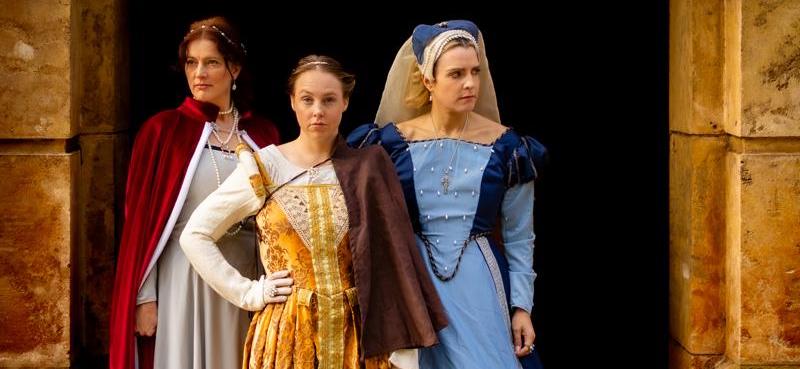“Divorced, Beheaded, Died, Divorced, Beheaded, Survived”
So goes the old ditty, gleefully recited by a fellow audience member standing near the bar during intermission.
Ladies Who Wait is currently being performed at the Subiaco Arts Centre. On the surface it’s a bawdy, dark comedy: the Tudor Queens brought to life through a series of improbable encounters with two common servants, Alice (Colleen Bradford) and Agnes (Fiona Forster).
Yet, there’s far more to this play. Yvette Wall, its playwright, has well and truly subverted that old rhyme. These Tudor Queens are, truly, queens, brought to life, embodied, granted agency, no longer merely the objects of that horrible chain of verbs.
We first meet Anne Boleyn (played by a riveting Emily Howe) on the night before her execution. In contrast with the rather slapstick servants, Anne is serious, sombre, reflective… angry: a simmering anger which slowly comes to a roiling boil. Anne is first helped in the development of her ire by the thoughtless, selfish servants; things really come to a head when she encounters her former lady-in-waiting, a magnificently gormless Jane Seymour (Maree Cole.)
In what initially feels like an aside, we encounter the gloating ghost of Catherine of Aragon (Jennifer McGrath.) She eagerly anticipates the death of her usurper, yet her joy is brought to nothing by the prospect of spending eternity with the soon-to-be-dispatched Anne. We are brought to wonder whether her anger was misdirected.
We return to Anne. As she stares out, past the audience, towards the jeering crowd gathered to witness the spectacle of her death, her anger comes to the fore. Encouraged by her servants, she bellows her distress, harnessing the vulgar language of those commoners, screaming out obscenities. It’s a gripping moment. Unlike her antecedent, this Queen lets fly while she is still alive, her white-hot rage directed first at the crowd, then Jane, and finally finding its true mark: Henry.
Then she is gone, dead, taken away in a red flash.
“Divorced, Beheaded, Died, Divorced, Beheaded, Survived”
We now leave behind that chain of Tudor women, and meet the next generation.
Continuity is found in the servants, who stumble, improbably and haplessly, upon a sleeping, ‘pregnant’ Queen Mary (a second role for Jennifer McGrath). McGrath plays a captivating, wild-eyed, dangerous, even at times terrifying Mary, who gleefully quizzes the servants to establish their Catholicity.1 She speaks rapturously of fire, of burning - she seeks out the opportunity to immolate her subjects with an almost lusty eagerness. The triumph of 16th century Protestant historiography, the legacy of Foxe’s Book of Martyrs which so effectively characterised Mary as a bloodthirsty zealot, goes unchallenged by this play.
Before Mary can actually secure the servants on a bonfire, the scene is interrupted by the arrival of Elizabeth2 (Maree Cole’s second part). Elizabeth is a rakish, swashbuckling counterpart to her older sister – boldly masculine. There is an intense energy between Cole and McGrath as their characters fence with each other, the dying Mary vainly exerting the last of her power in an attempt to prevent Elizabeth uttering the name, and thereby retrieving the memory, of her mother Anne.
Over the course of her time on stage, Mary’s painful decline becomes more and more prominent, even as the verbal duelling continues. Mary comes to vent her anger: anger at her sister, anger at the duration and pain of what she believes to be pregnancy, anger even at God for the unjust pain that comes with her anatomy (perhaps a defiant retort to Genesis 3:16.)
The servants are enlisted as hapless midwives, their efforts to intervene eventually joined, cruelly and fatally, by Elizabeth. With another red flash, Mary is gone.
What meaning is there in all of this?
This play is very far from being a literal history – there’s something else going on. Its crass bawdiness evoked many a belly-laugh from the audience: but this is humour that finds its origin in a pain held in common between audience, cast, and playwright. There’s a thread connecting the women of this play: the trauma they’ve received from a society that views them not as people, but as objects.
“Divorced, Beheaded, Died, Divorced, Beheaded, Survived”
This work liberates its women from that ditty, surfacing the consequences of the kind of thinking that it implies. Its bawdiness flashes over into anger, and more than that, power, agency, rebellion.
As Howe’s Anne dressed down her tormentors, a verse from the Book of Job came into mind.
“Therefore I will not restrain my mouth; I will speak in the anguish of my spirit; I will complain in the bitterness of my soul. (Job 7.11)
There’s a resonance between the experience of Job, and the intergenerational experience of this play’s Tudor women. As the play ends, Queen Elizabeth marches off defiantly into history, leaving us with a glimpse of the transformational potential of righteous anger. It’s a great play: get along and see it if you can.
(Photo pinched from the Off the Wall Produtions Facebook page.)
-
It was a surprisingly hard quiz, I’m not sure I would have passed! ↩︎
-
As Elizabeth entered, a large portrait of Henry VIII fell off the stage wall and onto the floor with a mighty crash. I’m not sure whether this was intentional, or an accident: if it was an accident, Cole handled it masterfully. Whichever way, it brought to mind a similar incident in Fleabag. ↩︎
